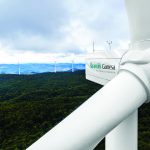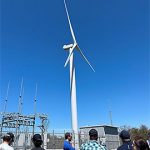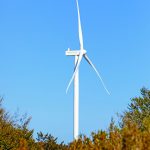After the record low wind anomalies that challenged many project operators in the United States in the beginning of the year, wind energy performance is expected to remain below normal in most regions into the final quarter of 2015. This is due to a persistent El Niño that is forecast to remain in effect throughout the end of the year.
The prediction was released today by Vaisala, a global leader in environmental and industrial measurement, based on its analysis of historic and forecast deviations from average wind conditions across North America.
The wind forecast anticipates that power producers in the Northeast, Northwest, and much of the U.S. wind belt will see below average wind speeds in Q4 2015. While the El Niño pattern largely has a negative impact, particularly along the Rocky Mountains, it will have a positive impact in some areas with significant wind generation.
The Southwest, Southeast, Indiana, and southern Texas are all expected to see above normal wind speeds. California is an especially bright spot with a high likelihood of elevated wind speeds, which should signal a return to smooth profitability for investors following the lows of the last six months.
Vaisala has been following the evolution of North American wind anomalies in particular detail since the release of its Q1 study revealing 40-year record low wind speeds. The low wind event caused significant reductions in generation for utilities and project owners, a number of whom reported expected shortfalls in quarterly and annual wind production.
 In the first quarter of the year, wind production in southern California fell to just 64% of 2014 levels, recovering somewhat in the second quarter to 80% of 2014 levels. Texas wind production was 93% of 2014 levels over the first half of the year. However, it is important to bear in mind that year-over-year nameplate wind capacity increased in Texas by 10%, meaning actual production was much lower in 2015 than in 2014 given the number of plants in operation.
In the first quarter of the year, wind production in southern California fell to just 64% of 2014 levels, recovering somewhat in the second quarter to 80% of 2014 levels. Texas wind production was 93% of 2014 levels over the first half of the year. However, it is important to bear in mind that year-over-year nameplate wind capacity increased in Texas by 10%, meaning actual production was much lower in 2015 than in 2014 given the number of plants in operation.
Since the end of Q1, wind speeds west of the Rocky Mountains have remained lower than average, though to a much lesser extreme, while an area from Texas northward to the Hudson Bay saw wind speeds 10-20% above normal in May. In June, widespread low wind speeds returned with most areas west of the Mississippi River seeing below normal conditions. Rocky Mountain states and central and northern California were especially hard hit with wind speeds roughly 20% below normal.
Large-scale anomalies such as this can lead to cash flow fluctuations that threaten profitability and the perception of wind energy as a low-risk investment proposition. For capital providers seeking stable returns through YieldCo structures in the U.S. market, this Q1 and Q2 underperformance serves as a strong reminder to better diversify portfolios by geography and technology to account for the underlying variability of the climate.
As wind power operations continue to expand across North America, placing recent performance in a long-term context and monitoring production against resource availability will become increasingly critical to portfolio profitability and investor reporting.
“For managing portfolio risk, it is imperative to have a detailed understanding of how over or underperformance at each of your project sites fits within the historical record,” said Dr. Jim McCaa, Manager of Advanced Applications at Vaisala. “As acquisition and merger activity increases, the industry also needs to start thinking strategically about the variability of the assets they are looking to buy and how they fit within the existing portfolio.”
As mentioned above, Vaisala’s forecast is based on the wide agreement of the atmospheric research community and all the major global weather models that the current El Niño climate signal will continue through the end of the year. The forecast was created using an ensemble approach blending mesoscale model predictions with three of the leading reanalysis datasets, each representing 35 years of climate data.
For further information, please download Vaisala’s 2015 U.S. Wind Performance Maps , which include the Q4 forecast as well as details on wind conditions experienced from January through June across the country.
Vaisala is an expert in wind measurement, project assessment, and energy forecasting. For more information on the range of services offered by Vaisala to the renewable energy sector, please visit www.vaisala.com/energy.



































